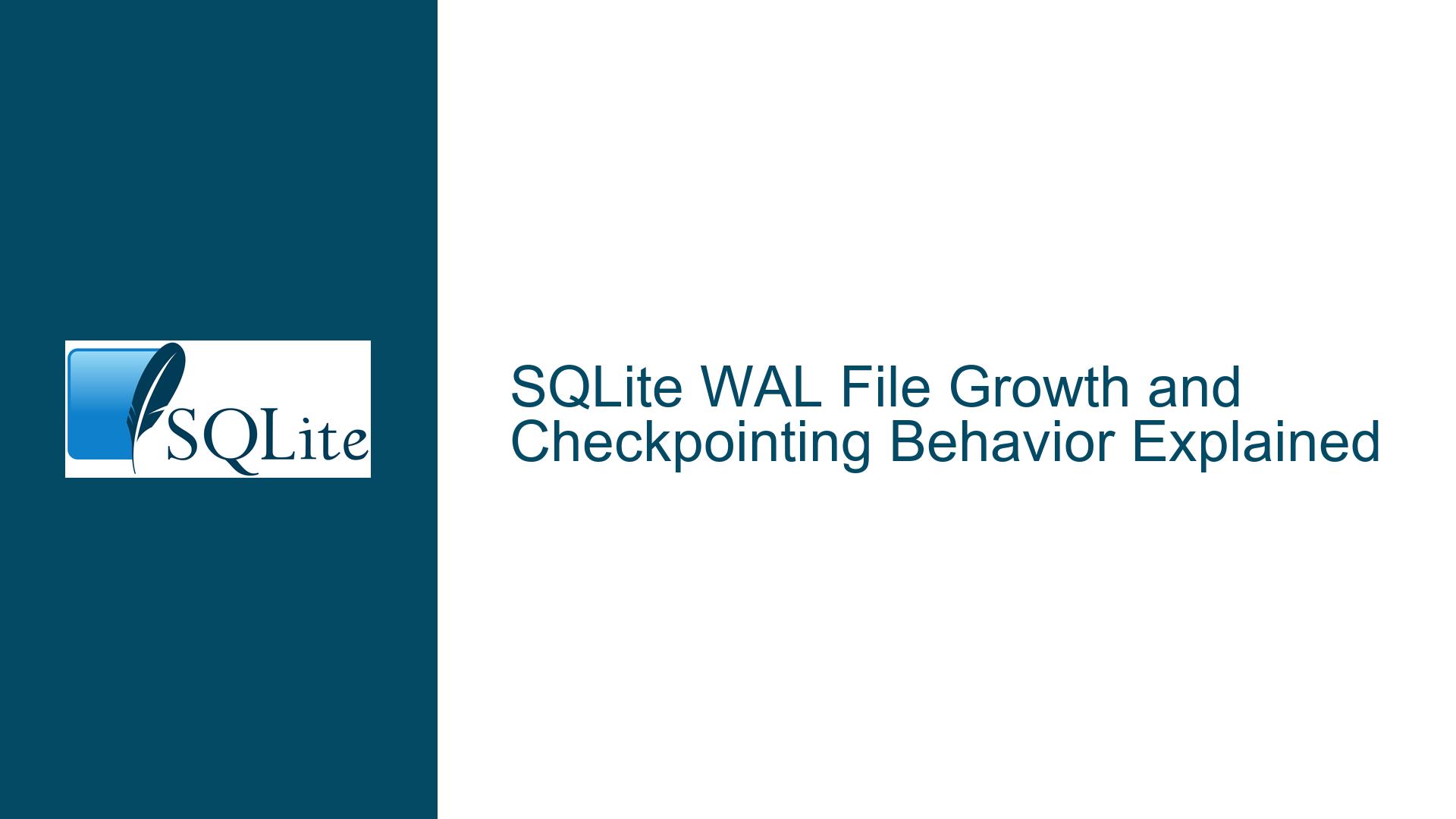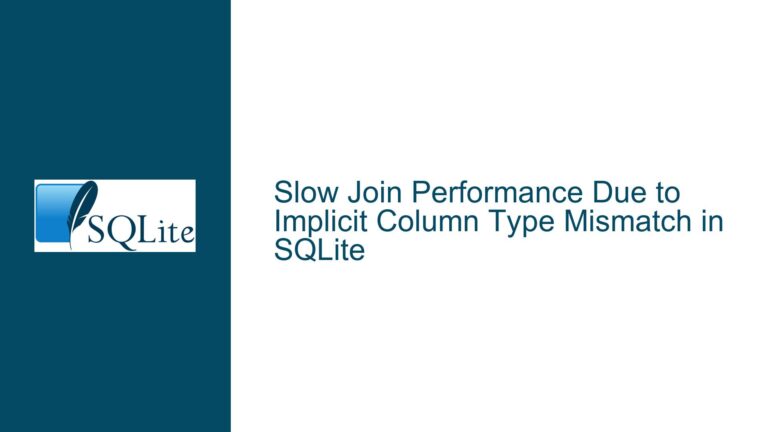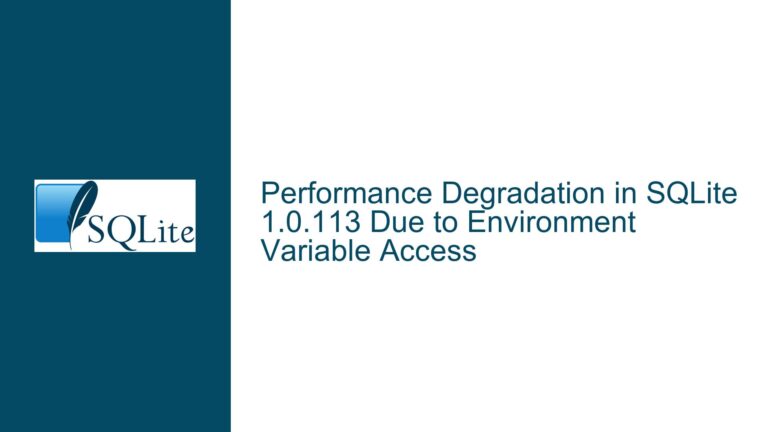SQLite WAL File Growth and Checkpointing Behavior Explained
WAL File Growth During High-Stress Multi-Threaded Operations
When using SQLite in Write-Ahead Logging (WAL) mode with the synchronous setting configured to NORMAL, the WAL file can grow significantly during high-stress operations, particularly in multi-threaded environments. This growth occurs because the WAL file accumulates changes made to the database without being truncated until a checkpoint operation is performed. Checkpoints are essential for transferring changes from the WAL file back into the main database file, thereby allowing the WAL file to be reset or truncated.
In scenarios where a unit test or application performs a high volume of write operations across multiple threads, the WAL file can grow to several gigabytes in size. This growth is not inherently problematic, as the WAL file is designed to handle such scenarios. However, it can become an issue if the file grows unchecked due to delayed or inhibited checkpoint operations. The WAL file is only removed when all database connections are closed, which means that during the lifetime of an application, the file can persist and grow significantly.
The behavior of the WAL file is influenced by several factors, including the frequency of checkpoint operations, the presence of long-running read transactions, and the configuration of the journal_size_limit pragma. The journal_size_limit pragma is intended to limit the size of the journal file, but it does not directly control the size of the WAL file. Instead, it applies to an empty journal file, which means it has no effect on the WAL file once it starts growing.
Checkpoint Starvation and Long-Running Transactions
One of the primary reasons for unchecked WAL file growth is checkpoint starvation, which occurs when checkpoint operations cannot complete successfully. Checkpoint starvation can happen due to several reasons, including the presence of long-running read transactions or large write transactions that prevent the checkpoint from reaching the end of the WAL file. When a checkpoint cannot complete, the WAL file continues to grow as new changes are appended to it.
In a multi-threaded environment, long-running read transactions are a common cause of checkpoint starvation. These transactions hold a snapshot of the database, preventing the checkpoint from reclaiming space in the WAL file. Similarly, large write transactions can delay checkpoint operations, as the checkpoint must wait for these transactions to complete before it can proceed.
Another factor that can inhibit checkpointing is the improper handling of SQLite statements. If a sqlite3_step() function is called but the corresponding sqlite3_finalize() or sqlite3_reset() functions are not called, the statement remains active, potentially blocking checkpoint operations. This can lead to a situation where the WAL file grows indefinitely until the application terminates and all connections are closed.
Implementing PRAGMA journal_size_limit and Manual Checkpointing
To address the issue of WAL file growth, several strategies can be employed. The first is to use the PRAGMA journal_size_limit setting to impose a size limit on the journal file. However, as previously mentioned, this setting only applies to an empty journal file and does not directly limit the size of the WAL file. Despite this limitation, setting a journal_size_limit can still be beneficial, as it ensures that the journal file does not grow excessively during normal operations.
A more effective approach is to manually trigger checkpoint operations at strategic points in the application. This can be done using the sqlite3_wal_checkpoint() function, which forces a checkpoint to occur. By periodically invoking this function, the application can ensure that the WAL file is truncated regularly, preventing it from growing unchecked. This is particularly useful in high-stress scenarios where automatic checkpointing may be delayed or inhibited.
In addition to manual checkpointing, it is important to ensure that all SQLite statements are properly finalized or reset. This prevents statements from remaining active and blocking checkpoint operations. Properly managing database connections and transactions is also crucial, as long-running transactions can significantly impact the performance and behavior of the WAL file.
The following table summarizes the key factors influencing WAL file growth and the corresponding solutions:
| Factor | Description | Solution |
|---|---|---|
| High-Stress Write Operations | High volume of write operations across multiple threads | Implement manual checkpointing using sqlite3_wal_checkpoint() |
| Checkpoint Starvation | Long-running read transactions or large write transactions | Ensure proper management of transactions and connections |
| Improper Statement Handling | sqlite3_step() called without sqlite3_finalize() or sqlite3_reset() | Always finalize or reset SQLite statements |
journal_size_limit Setting | Limits size of empty journal file but not WAL file | Use in conjunction with manual checkpointing for better control |
By understanding the factors that contribute to WAL file growth and implementing the appropriate strategies, developers can effectively manage the size of the WAL file and ensure optimal performance in high-stress, multi-threaded environments. Properly configuring checkpoint operations and managing database connections are key to preventing unchecked WAL file growth and maintaining the stability and efficiency of SQLite databases.






